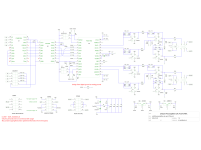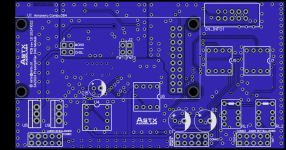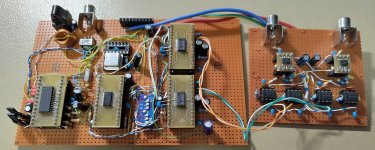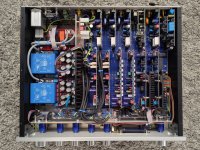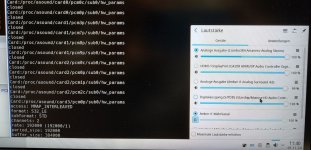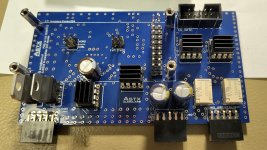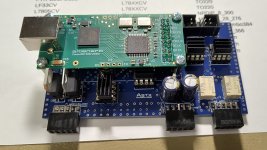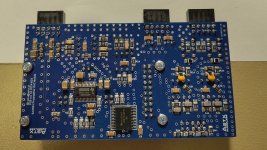What a project! Chapeau! Looking at the MM input, I see that you don't have any (selectable) input capacitor(s). Do you depend on the phono cable alone to provide the recommended cartridge load capacitance?
SA2024 preamplifier DAC Module
First beta release. Have a look and feel free to report errors if there are any 😉
Have fun, Toni
First beta release. Have a look and feel free to report errors if there are any 😉
Have fun, Toni
Attachments
Why combine the balanced output of the PCM and then separate it again to make it balanced? Why not a direct, straight balanced output?
The output of U4 and U6 is -4.65 Volt on digital silence. So we would need extra 4 big decoupling caps (e.g.470uF/35) on output after the filter stage to get 0V on digital silence. The monitor output should also have no high bias voltage to avoid any plop tones. Recreating the balanced signal for output with the extra opamp is a often used trick. E.g. the volume controller first creates a SE signal, otherwise we would need doubled number of relais. Output afterwards recreates a balanced signal again.
BR, Toni
BR, Toni
I see - you have used the PCM2706 as I2S converter. Unfortunately you could do only maximum of 48kHz I2S. I remember I have build such an usb audio board a decade ago around 2011.
Attached a photo from the same year with a dual mono pcm1794a. It worked, but I have never prepared a pcb.
BR, Toni
Attached a photo from the same year with a dual mono pcm1794a. It worked, but I have never prepared a pcb.
BR, Toni
Attachments
About posts #104 and #105:
Wouldn't be better, if You connect second U5 the same way as first U5 (that is a differential amp), but with inputs swapped?
That way both outputs have the same phase shift and delay, ant, most important, looks way better 😉.
(My description may not be clear, so I'll try draw picture later)
Wouldn't be better, if You connect second U5 the same way as first U5 (that is a differential amp), but with inputs swapped?
That way both outputs have the same phase shift and delay, ant, most important, looks way better 😉.
(My description may not be clear, so I'll try draw picture later)
Nice to hear from you!
I have had something like this in mind but was lazy and decided to go the save way.
This variant needs to be carefully simulated. The 2nd filter has to be added in the second stage and the error of the common voltage should be compared to the "save" variant.
Of course there should be no big dc offset to avoid the need of lytics at the output.
BR, Toni
P.S.: pcb rev is 1.0
no problem here if we go for a 1.1 revision. 😉
I have had something like this in mind but was lazy and decided to go the save way.
This variant needs to be carefully simulated. The 2nd filter has to be added in the second stage and the error of the common voltage should be compared to the "save" variant.
Of course there should be no big dc offset to avoid the need of lytics at the output.
BR, Toni
P.S.: pcb rev is 1.0
no problem here if we go for a 1.1 revision. 😉
Last edited:
The newest family member of the preamplifier input modules "SA2024 Preamplifier DAC module" based on PCM1794A is working out of the box.
Wow!
I'm really surprised because this was my first smd project using such small 28 pin dac chip.
To solder the PCM1794A in my cheap reflow oven T-962 needed a 2nd run with extra flux. Haven't had 22pF SMD C0G so I used small through hole C0G parts.
The sound is absolutely clear. The USB part is galvanically isolated from the preamplifier. I have used the ISO7640FM as shown in the combo384 datasheet.
These sampling rates are tested: 44.1, 48, 88.2, 96, 176.4, 192 kHz. A modern Linux has the UAC2 driver for the Amanero Combo384 allready included.
Have fun,
Toni
Wow!
I'm really surprised because this was my first smd project using such small 28 pin dac chip.
To solder the PCM1794A in my cheap reflow oven T-962 needed a 2nd run with extra flux. Haven't had 22pF SMD C0G so I used small through hole C0G parts.
The sound is absolutely clear. The USB part is galvanically isolated from the preamplifier. I have used the ISO7640FM as shown in the combo384 datasheet.
These sampling rates are tested: 44.1, 48, 88.2, 96, 176.4, 192 kHz. A modern Linux has the UAC2 driver for the Amanero Combo384 allready included.
Have fun,
Toni
Attachments
Last edited:
Fix for 2x17 power supplies to be more accurate at 2x17V. Before the voltage was a little bit too high (each about 17.5V) which could decrease the lifetime of the used opamps.
Attachments
Last edited:
The sound of this PCM1794A DAC is always a pleasure. The resolution of the very fine details is outstanding. Even if this DAC is not capable of doing 32bit resolution - who cares. A preamplifier built in high end DAC is/was always my a dream. I like it - you too? (you can still use an external DAC - your decision)
Using the headphone if I press pause on my "amarok" player even with +12 gain there is no noise and hum - total silence. Wow!
I have so much fun listening, Toni
Using the headphone if I press pause on my "amarok" player even with +12 gain there is no noise and hum - total silence. Wow!
I have so much fun listening, Toni
Last edited:
Toni,
How does it sound in conjunction with your power amps (SA2014, SA2016, SA2016)? I'd also be interested in the price for the individual module boards if that's not a secret 🙂
Regards Roman
How does it sound in conjunction with your power amps (SA2014, SA2016, SA2016)? I'd also be interested in the price for the individual module boards if that's not a secret 🙂
Regards Roman
Roman you've got an email.
The sound is - "surprise" - like a wire with gain! You can hear all fine details of the source (and all errors which have been made during mastering the record like hum, bad distortions from non harmonic guitar overdrive ...)
Have fun, Toni
The sound is - "surprise" - like a wire with gain! You can hear all fine details of the source (and all errors which have been made during mastering the record like hum, bad distortions from non harmonic guitar overdrive ...)
Have fun, Toni
- Home
- Source & Line
- Analog Line Level
- SA2022 - Modular High End Analog Precision Preamp (with headphone amp, digital controlled relay volume, monitor output, IR remote, SE and bal. I/O)
